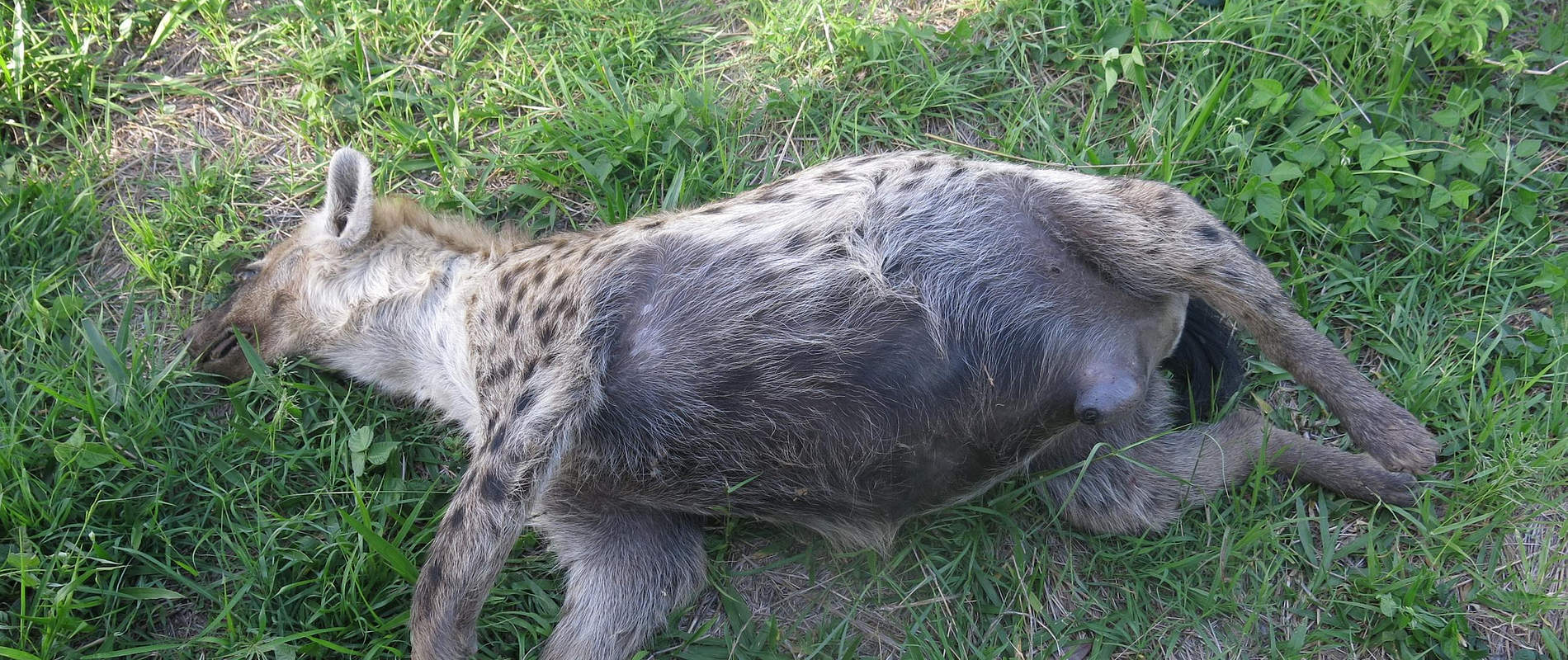MASAI MARA FIELD VETERINARY REPORT FOR MARCH 2017 By Dr
MASAI MARA FIELD VETERINARY REPORT FOR MARCH 2017
By Dr. Campaign Limo
Introduction
The month experienced a lot of precipitation with most seasonal rivers becoming flooded. This came as a relief for most herbivores as availability of forage was guaranteed. Conflict cases consequently decreased as competition with humans and domestic animals declined.
The following are cases handled during the period:
CASE#1 TREATMENT OF AN ARROWED GIRAFFE
Date: 9th Mar 2017
Species: Masai giraffe
Sex: Male
Age: Adult
Location: Olarro conservancy
History
This giraffe was seen with a swelling on the left side of his withers by the Olarro Conservancy Rangers who informed their management. He was in a herd of ten giraffes and the others were in good condition. He stayed a few meters from the rest of the herd and was clearly in pain whilst walking.
Immobilization, examination and treatment
Immobilization was achieved by use of a combination of 12mgs Etorphine hydrochloride and 50mgs Azaperone delivered through a 3ml dan-inject dart from a vehicle. It took eight minutes for the drugs to take full effect whereupon he was roped down for effective restraint.
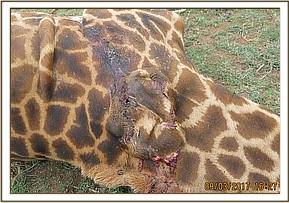

Examination revealed an arrow head lodged in the giraffes withers which had created sepsis and maggot infestation. The arrowhead and all maggots were manually removed from the wound. It was suspected the arrowhead had been poisoned.
The wound was debrided and all necrotic tissues removed. Tincture of iodine was then applied as a disinfectant. He also received 7500mgs Amoxicillin antibiotic and 1500mgs Flunixin meglumine anti-inflammatory intramuscularly. To stop maggot re-infestation, 200mgs Ivermectin parasiticide was administered subcutaneously.

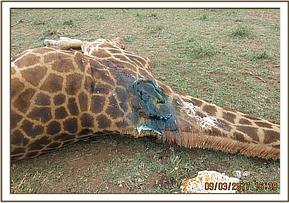

Reversal and Prognosis
Reversal of the anaesthetic was achieved by intravenous injection of 150mgs Naltrexone. He rose up to join the rest of the herd. Prognosis is good.
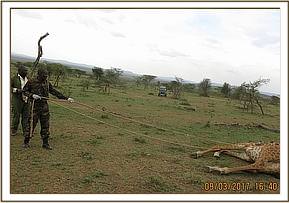
CASE#2 TREATMENT OF AN ARROWED ELEPHANT
Date: 20th March 2017
Species: African elephant
Sex: Male
Age: Adult
Location: Masai Mara National Reserve.
History
This lone bull was seen by the veterinary mobile team as he came towards their residence to drink water. He was limping on his front left leg with a swelling near his elbow. He moved with some degree of pain though he appeared to be in good body condition.
Immobilization, examination and treatment
He was restrained chemically by use of 16mgs Etorphine hydrochloride delivered through a 3ml dan-inject dart.Induction time was ten minutes and he assumed right lateral recumbency. Examination of the swelling revealed an old but septic wound most likely caused by an arrow.


The wound was probed for foreign bodies but none were found; presumably the arrowhead had been dislodged over time. The wound was debrided with dilute Hydrogen peroxide, lavaged with clean water before tincture of iodine was applied to disinfect. Green clay was then applied to the wound to facilitate healing.
He additionally received a parenteral administration of 22500mgs Amoxicillin antibiotics and 5000mgs Flunixin meglumine anti-inflammatory.
Reversal and Prognosis
Reversal of the anaesthetic was achieved by administration of 150mgs Naltrexone intravenously through a prominent ear vein. He rose up in three minutes and dashed into a nearby thicket. Prognosis is good.

CASE#3 COLLECTION OF WHOLE BLOOD FROM AN ELEPHANT BULL
Date: 22nd March 2017
Species: African elephant
Age: Adult
Sex: Male
Location: Masai Mara National Reserve
History
Most of the young elephant calves rescued from the wild need to have their immunities boosted to survive regular health challenges. Some of them are rescued very young before getting the full benefits of their mother’s colostrum. Whole blood from adult healthy males is normally collected for serum extraction to be used to boost their immunities.
Immobilization and blood collection
This bull was chemically restrained by use of 17mgs Etorphine hydrochloride delivered through a 3ml dan-inject dart.It took ten minutes for the drugs to take full effect with this massive bull assuming right lateral recumbency. Blood was collected from visible ear veins to new blood bags. The procedure took slightly over twenty minutes after which the anaesthetic was reversed.
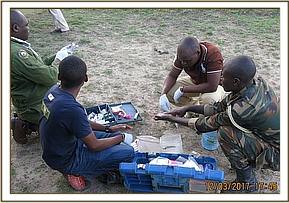

Reversal
Reversal of the anaesthetic was achieved by administration of 200mgs Naltrexone intravenously through a prominent ear vein. He rose up in three minutes and took off to a nearby bush.
The collected blood was flown immediately to competent laboratories in Nairobi for processing.
CASE#4 POST MORTEM OF A SPOTTED HYENA
Date: 23rd March 2017
Species: Spotted hyena
Sex: Female
Age: Sub adult
Location: Aitong (Near Naretoi)
History
This hyena was seen by Naretoi management late evening on the 22nd March with signs of posterior ataxia and vomiting; she died soon after. Management called the veterinary unit for help to determine the cause of her death.
General observation
This hyena appeared to have been in good body condition before her death. No other hyena or any other species carcass was seen or reported in the area. There were also indications that she vomited before death.
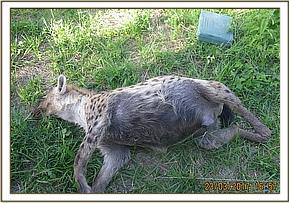

On opening the carcass, the following was noted;
- There were signs of lung congestion with froth evident on the trachea.
- Oesophagus was partially eroded with traces of refluxed greenish material sticking onto the mucosa
- Liver and kidneys appeared congested with the liver showing cooked appearance
- The stomach was empty. No food traces found
- Spleen was heavily engorged
- The lower portion of small intestines and part of large intestines were congested and necrotic with clear evidence of severe intestinal torsion. The mesentery at the point of torsion was tense with 360 degrees rotation along its own axis.
- No other pathology detected grossly
Conclusion
This hyena died of severe intestinal torsion.
CASE#5 INJURED LION
Date: 23rd March 2017
Species: African lion
Sex: Male
Age: Adult
Location: Masai Mara National Reserve (Talek area)
History
This lion was seen by Masai Mara National Reserve Rangers who reported that the lion was limping with an injury to one of his hind legs.
The Vet Unit found this male inside a small bush next to his brother and he looked very agitated. His left hind leg appeared wasted from a long term injury causing atrophy though disuse but still there was a fresh wound that caused concern.
Immobilization, examination and treatment
Chemical Restraint was achieved with a combination of 6mgs Medetomidine and 25omgs Ketamine delivered in a 3ml dan-inject dart. The lion was darted from a vehicle though this was quite a challenge because he was aggressive and did not want to be approached.
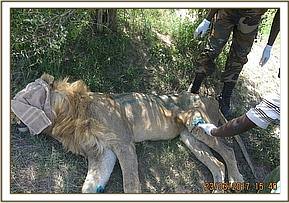

Finally he was darted and examination revealed a freshly inflicted spear wound hardly 24hours old. The wound was about 4inches deep accessing the knee joint and damaging joint cartilage. He had also suffered a long term injury on the same leg diagnosed as hip subluxation.
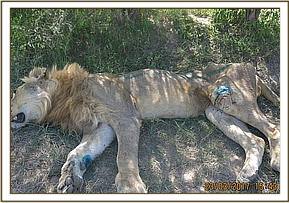
The wound was cleaned with water, disinfected with iodine and infused with cloxacillin ointment.
Damaged tissues were sutured together and the skin closed leaving a small space for discharge. He received an injection of 3000mgs Amoxicillin antibiotic intramuscularly and 80mgs subcutaneous injection of Ivermectin parasiticide.
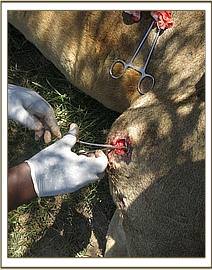
Reversal and Prognosis
Reversal of the anaesthetic was achieved by administration of 20mgs Atepamezole hydrochloride intramuscularly one hour after immobilization. He got up after ten minutes and relaxed under a shade.
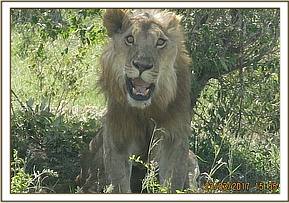
Prognosis is fair as the injury is not life threatening and he has survived so far with the older injury.
Conclusion
The Mara Mobile Veterinary Unit is thankful to all stakeholders who over the period brought to their attention wild animals that required help. We thank the Minara foundation through DSWT for continuous facilitation to the unit. We are also grateful to KWS management for their technical support to the unit.
